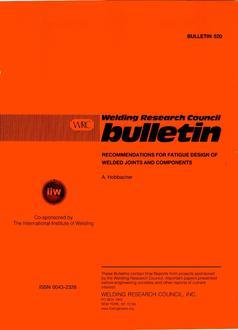Cart 0 Product Products (empty)
No products
To be determined Shipping
$0.00 Total
Product successfully added to your shopping cart
Quantity
Total
There are 0 items in your cart. There is 1 item in your cart.
Total products
Total shipping To be determined
Total
New Reduced price!  View larger
View larger
 View larger
View larger WRC 520
M00022826
New product
WRC 520 Recommendations for Fatigue Design of Welded Joints and Components
Bulletin / Circular by Welding Research Council, Inc., 2009
A. Hobbacher
In stock
More info
Full Description
This Bulletin represents many years of effort by the experts of the Joint Working Group on Fatigue Design Rules. The main points are: on structural hot spot stress, consideration of aluminum at the effective notch stress method, improvement techniques and multi-axial loading. WRC supports USA participation in IIW via the American Council for IIW, a collaborative body of WRC, the American Welding Society and the Edison Welding Institute. The Bulletin is published under an agreement between WRC and IIW. Commission XIII: Fatigue Behavior of Welded Components and Structures consists of the following Sub-Commissions and Working Groups: Fatigue Testing and Evaluation of Data for Design; Techniques for Improving the Fatigue Strength of Welded Joints; Hot-Spot Stress Method in Fatigue Analysis of Welded Components; The Influence of Weld Defects in Fatigue-Loaded Structures; Life Extension of Welded Structures by Repair, Retrofitting and Structural Monitoring; Fatigue Design Rules. The International Institute of Welding (IIW) has for sixty years served as a remarkable instrument for professionals from many nations to exchange information, work on common problems and prepare publications with recommendations for best practices associated with welding.The aim of these recommendations is to provide a basis for the design and analysis of welded components loaded by fluctuating forces, to avoid failure by fatigue. In addition they may assist other bodies who are establishing fatigue design codes. It is assumed that the user has a working knowledge of the basics of fatigue and fracture mechanics.
The purpose of designing a structure against the limit state due to fatigue damage is to ensure, with an adequate survival probability, that the performance is satisfactory during the design life. The required survival probability is obtained by the use of appropriate partial safety factors.

